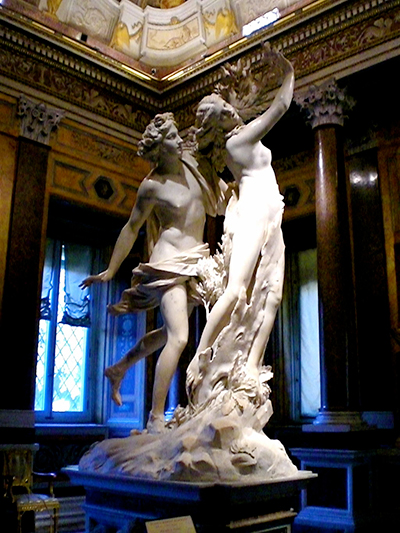There is a fascinating story behind the sculpture Apollo and Daphne by Gian Lorenzo Bernini. The sculpture was inspired by a story from the tale of Ovid’s Metamorphosis.
Apollo, the god of light and poetry, teased Cupid about how young he was to handle the bow and arrow, terming them as very dangerous to a young boy. Apollo’s remarks evoked some spite in Cupid and as part of his revenge; he pricked the god with his arrow and made him fall madly in love with a nearby river nymph Daphne. Sadly, Daphne could not fall in love with Apollo as she had devoted all her life to serving Diana and had decided to remain a virgin and unmarried.
Seeing the lust in Apollo’s eyes as he pursued her, she cried out to her father, the river god to rescue her and in turn, he turned her into a laurel tree. Apollo took home the tree as he declared that if she was not going to his lover, then she will at least be his tree. In this sculpture, Gian Lorenzo Bernini captures the exact moment when Daphne was transforming into a tree. A close look at the sculpture will reveal the transformation as seen on Daphne’s fingers turning to leaves, her toes turning into roots and the bark of a tree that is developing up her torso.
Gian has managed to capture the exact moment of Daphne’s transformation. Though the sculpture is immobile, viewers can get the sense of movement through Apollo’s hanging piece of cloth, Daphne’s hair and hands, and the two figures’ legs seem to be in motion. Bernini is known in history as the master of baroque in the 17th and the 18th century. In the Apollo and Daphne sculpture, Bernini perfectly shows the energies in the two figures, portraying motion in the sculpture. The style is also evident in the concealed lighting and shadows in the sculpture.
Apollo and Daphne sculpture has captured the emotions and tension, from the tale, as seen in the life-like action of the two figures. Bernini always manages to bring out some life in his sculptures. In the Apollo and Daphne sculpture, Bernini has focussed on features that have helped the sculpture portray human emotions and brought out the life in the sculpture. Viewers can almost see Daphne’s transformation taking place at the moment and Apollo’s shock can be seen through his fingers and facial expression.
Apollo and Daphne is a marble sculpture with life-sized dimensions. The sculpture was commissioned by Cardinal Scipione Borghese in 1622. It is now displayed at Galleria Borghese. It is believed that Giuliano Finelli was part of the creation of Apollo and Daphne sculpture. He played a huge part in creating Daphne’s transformation. In 1670, Giovanni Battista Foggini was greatly inspired by the baroque style, pioneered by Bernini, to create sculptures with the same life-like energy and emotions; as seen in the Apollo and Daphne sculpture.




